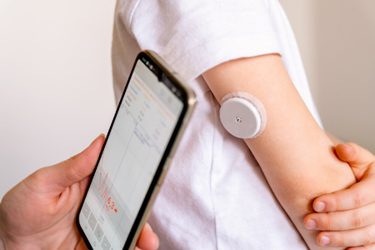How Is The Diabetes Management Device Landscape Evolving?
A conversation with Francine Kaufman, M.D., Senseonics

It’s now been over a century since the first patient received a dose of insulin to treat diabetes.1 Over this time, the prevalence of this chronic condition has continued to grow, with an estimated 537 million adults now living with diabetes worldwide.2 Despite this, for much of the last 100 years, diabetes management only saw incremental improvements. That’s until the last decade or so, when patients have benefited from a true evolution in technology and treatments.
To find out more about the latest developments, innovations, and what the future holds, we caught up with Francine Kaufman, M.D., an endocrinologist who has served as president of the American Diabetes Association and chaired the National Diabetes Education Program. Alongside her position as Distinguished Professor Emerita of Pediatrics and Communications at the University of Southern California, she has been a practicing physician for almost 45 years. She joined Senseonics in 2019 as the Chief Medical Officer.
What area of diabetes management has evolved the most in recent years?

Where we have seen the most evolution in diabetes management, however, is with medical devices and technology. Over the past few years, a number of new technologies have been developed, launched, and adopted into standard practice for many. Given the need for continuous monitoring and management of blood sugar, devices and digital solutions have been advancing at a phenomenal rate, revolutionizing the way people are able to track and treat their diabetes. Ultimately, these products are reducing burdens associated with diabetes, while improving outcomes and our understanding of the condition.
What are the most used products on the market right now for diabetes management and why? Do you see the market changing for any specific types of devices in the near future?
KAUFMAN: I’d say that the two key product-types on the market right now are continuous glucose monitors (CGMs) and insulin pumps. CGMs have been the most significant development that I’ve seen during my 40+ year career as an endocrinologist. These devices work via a tiny sensor, inserted through or under the skin, that measures glucose levels in the cell’s interstitial fluid rather than in the blood. They allow people to seamlessly track their glucose levels throughout day and night, sending readings to a mobile device where they can gain actionable, data-led insights on how to improve their diabetes management.
This is a huge leap forward from fingerstick testing for blood glucose, and it unlocks a wealth of information that can inform longer-term behavioral changes that improve individual health outcomes. CGMs have been shown to reduce hospitalizations and even save expense in the medical system, so there is no doubt that anyone taking insulin should have a CGM if they want one. CGMs will likely expand even further into the general population as a behavior change tool — such as we are beginning to see in combatting obesity and by athletes for optimizing physical performance.
Then we have pumps, which are very important for people using insulin. Attached to the body, these small electronic devices administer insulin via a small tube or patch, replacing self-administered injections. Although this method of insulin delivery doesn’t suit everyone, pumps have been game-changing for many and have become common in the U.S.
Neither insulin pumps nor CGMs are going anywhere. I see them remaining in place as the two most fundamental devices in the market for years to come. What we will see with these technologies, however, is further improvements, integration, and innovation.
What are the latest innovations in products on the market?
KAUFMAN: The integration of devices is really an important part of product innovation. Increasingly, people want to integrate their CGM with Apple Health on their cell phone or link it to their Fitbit, and it’s important that companies work together to make that happen, which they are. Aggregating data presents a huge opportunity to better understand patient behavior and associated outcomes. Crucially, this also improves the encounter between patient and healthcare providers, as having all the data in one place helps to draw a complete picture of an individual’s condition and adjust treatment regimens accordingly.
Then there’s a lot of interesting innovations in products individually, all working toward reducing the patient burden and improving quality of life. CGMs, for example, have improved by leaps and bounds. Innovation needs to focus on addressing patient needs and, as such, listening to people who live with the condition day to day is vital.
At Senseonics, when we were developing the latest iteration of our CGM, Eversense E3, we asked patients what they wanted. For example, we repeatedly heard that people wanted a longer lasting CGM, so we made one that lasts up to six months, and we have a year-long CGM sensor currently being tested in a clinical trial. Listening to patients is so important in diabetes care, as they are in charge of self-management and know their individual condition better than anyone.
Which advanced technologies are starting to get used in diabetes management devices in the market and how? How will patients benefit from the use of these advanced technologies?
KAUFMAN: Advanced technologies have opened the door to an exciting new era of diabetes management – automated insulin delivery (AID). Although still in its infancy, AID is where CGMs and pumps communicate to automatically decide and deliver insulin doses. Harnessing data and employing algorithms, AID systems can improve time in target blood glucose range and reduce hypoglycemia, which hopefully leads to a future where long-term health complications are minimized.
The prospect of AID systems is tantalizing. Right now, we are in a hybrid insulin delivery modality with so called closed-loop systems, where insulin is both delivered automatically and adjusted by the patient. However, the idea of creating a fully functioning artificial pancreas through the combination of devices and data is slowly becoming a reality.
Generally, data is driving a paradigm shift in diabetes care. The digital age is unlocking a future for people with diabetes in which diabetes management is no longer a burden. A data-driven approach to healthcare is facilitating the growth of an ecosystem full of interconnected digital solutions, helping people to look at their health holistically – which is key.
How does the future of diabetes management look?
KAUFMAN: The future of diabetes management looks bright – treatment options are ever expanding, devices are reducing the management workload, and data is closing the loop on holistic healthcare. One day, we will hopefully find a cure, but, in the meantime, I see a future where medical technology takes on a lot of the hard work that previously burdened patients.
On the pharmaceutical side, two new classes of medicines have emerged with a really significant effect on glucose management but also lead to a reduction of cardiovascular disease and weight. Sodium-glucose co-transporter-2 (SGLT-2) inhibitors and glucagon-like peptide-1 (GLP-1) agonists are changing the landscape of how we ever imagined treating type 2 diabetes. Cautiously, there is also some spillover of these positive effects of the GLP-1 agents into the type 1 population, but this is less established.
While both type 1 and type 2 diabetes are characterised by the body’s inability to control blood sugar levels, the cause, development, and treatment options differ. Even among those two populations, no two people’s diabetes is the same. Regardless, recent pharmaceutical developments are encouraging and there is much optimism for further breakthroughs, with the industry continuing to innovate and new targets coming forward that may be even more effective.
In parallel to treatments, we should also see a lot of advances in diabetes prevention. Last year, the FDA approved the first ever drug to delay the onset of type 1 diabetes. There have also been great developments in the prevention and even reversal of type 2 diabetes with digital therapeutics. Using apps and wearables that enable individuals to track their lifestyle and behavioral changes, it is possible to send type2 diabetes into remission — which is fantastic!
Nonetheless, it is important to note that there is a significant lag in the developing world. In low resourced areas of the globe, diabetes management looks very different. We need to work toward figuring out how to bring parity, regardless of where you live, in being able to access healthcare, pharmaceuticals, and medical technology. I think we're quite far away from that at this point, but we should not rest until we are there.
How is the industry working together to reach this future state?
KAUFMAN: We will reach this future state by the industry being both competitive and collaborative. Competition spurs innovation and collaboration brings these innovations to patients. We need both. There is no point in creating world-beating devices and solutions if no one can access them. For example, for our products at Senseonics, we drive the innovation in-house and then work with Ascensia Diabetes Care to bring these products to patients — this way everyone can focus on their strengths.
It is thought that the number of adults with diabetes will rise to 642 million by 2030 and to 783 million by 2045.2 These astonishing figures demonstrate just how important addressing diabetes will be in the coming years for healthcare systems globally. Ultimately, the diabetes space is lucky to have such a motivated and patient-focused community. Whatever we are developing, drugs or devices, we need to work together with patients in mind to build a brighter tomorrow for diabetes management.
References
- https://www.diabetes.org.uk/research/research-impact/insulin
- The IDF Diabetes Atlas Tenth edition 2021 - https://diabetesatlas.org/
